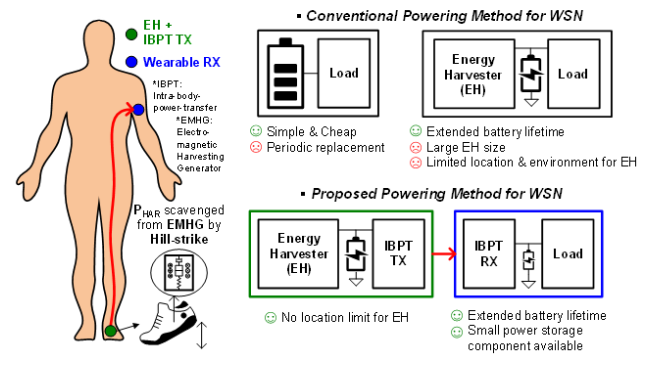Prof. Minkyu Je’s team at KAIST developed integrated circuit chips for an intra-body-power-transfer (IBPT) system energized by an electromagnetic (EM) energy harvester to power devices worn on various places of the body. The demand for smaller batteries in wearable devices has led to the exploration of alternative power supply solutions. While energy harvesting is a well-known method, it has limitations due to the transducer size and its suitability only in specific on-body locations and environments. For example, the hill-strike energy harvester is capable of obtaining a few mW of power. However, its application has been limited due to the scarcity of wearable devices and sensor nodes located in shoes. These size and location mismatch issues of energy harvesting can be resolved by IBPT, which utilizes the human body as a power transfer medium between the power transmitter (TX) at the energy harvester side and the receiver (RX) at the wearable device side. It allows power delivery through the human body, thus connecting the energy harvester’s output power to wearable devices.
Among various approaches for hill-strike energy harvesting, the EM-based approach harvests energy from sub-g acceleration during walking by converting vibration into electrical energy. Even with a volume of a few cm3, it can yield power of several mW at resonance and can be suitably installed in shoes. The proposed maximum-power-point-tracking (MPPT) method for EM energy harvesting offers simple implementation and fast MPPT tracking. Also, maximum-resonant-power-tracking (MRPT) is employed for the IBPT TX to track the optimal resonance frequency, which varies with environmental change.
Prof. Je’s team developed integrated circuit chips to construct an intra-body-power-transfer system energized by an electromagnetic energy harvester. The power TX, comprising an EM harvester and IBPT TX, is positioned in the shoe, converts mechanical energy from hill-strike into electrical energy, and transmits it to wearables via IBPT. The IBPT RX in wearables rectifies the received power to charge the battery. The team demonstrated successful power generation and transfer from a shoe-mounted power TX node comprising an EM harvester and IBPT TX to an IBPT RX node for the first time. This result was presented at the IEEE VLSI Symposium on Technology and Circuits held in Honolulu, Hawaii, from June 16 to 20, 2024.
“This research demonstrates that it is possible to overcome essential limitations of energy harvesting technology. To generate a meaningful level of power, transducers cannot be too small, limiting their use on arbitrary parts of the body. Additionally, the body parts suitable for power generation are also restricted, meaning that energy harvesters cannot be positioned with typical wearable devices. As such, if there is no appropriate method to transfer the power generated by the energy harvester to wearable devices located at a considerable distance, its utility would be severely limited. We have shown that this limitation can be overcome by transmitting power through the human body as a medium. Notably, we successfully demonstrated, for the first time in the world, the process of converting mechanical impact from a person’s gait into electrical energy and then transferring the generated power to a device located on the wrist, using integrated circuit chips we developed and a commercially available EM energy harvester mounted on a shoe,” said Minkyu Je, the corresponding author and a professor in the School of Electrical Engineering and the KAIST Institute for the Health Science and Technology at KAIST.
This work was supported by the ETRI Research and Development Support Program, funded by the Ministry of Science and ICT (no. IITP-2022-0-00020), and by the LGE-KAIST Digital Healthcare Research Center Program funded by LG Electronics. The chip fabrication was supported by the IDEC, Korea.


Prof. Minkyu Je, Hyungjoo Cho, Dongyoon Lee School of Electrical Engineering, KAIST
E-mail: mkje@kaist.ac.kr
Homepage: https://impact.kaist.ac.kr






